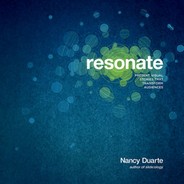
120 Resonate
Now that you’ve edited down the content, you’re going
to cluster it by topic and then turn the topics into dis-
crete messages. Grab a fresh piece of paper or a stack
of sticky notes and write out the three or so major topics
that support the big idea and spread them out, giving
them breathing room. The important points should be
top-of-mind after all the research you’ve done, but if
you’re struggling to limit them to five, it might take a bit
of mental negotiation to murder another darling or two.
Each topic should overlap as little as possible. Make
sure that nothing relevant to your big idea has been
overlooked. There’s a thinking process commonly used
at McKinsey called MECE (Mutually Exclusive and
Collectively Exhaustive):
Mutually Exclusive:• Each idea should be mutually
exclusive and not overlap with the others; other-
wise you will confuse the audience. (“Hey, haven’t
we talked about the acquisition already?”)
Collectively Exhaustive:• Don’t leave anything out.
If you plan to talk about your competitors, you
should not mysteriously leave one out. The audi-
ence expects you to be complete.
Once you’ve nailed down the key topics, list three to
five supporting ideas around each. To the right is an
example from a presentation announcing an acquisi-
tion that would be delivered at an employee meeting.
From Ideas to Messages
CH005.indd 120CH005.indd 120 8/16/10 4:26:15 PM8/16/10 4:26:15 PM

Create Meaningful Content 121
The topics you initially generate are usually a single
word or a sentence fragment. In the same way that a
big idea shouldn’t be a topic, these little ideas need
to be transformed into messages as well. Again, a
message should be a full sentence that’s emotionally
charged. Topics are neutral; messages are charged.
Now that you’ve created clusters of ideas around the
topics, you’re going to transform the topic into a key
message for each cluster.
Each message should feature as much contrast as
necessary to effectively communicate the point.
In the acquisition example on the left-hand page, the
first acquisition failed. They shouldn’t jump right into
discussing the new acquisition (what could be) with-
out acknowledging the first failed acquisition (what
is). The message of the new acquisition must include
an acknowledgment of what was learned from the
previous failings, or the audience will feel like this new
acquisition will fail also.
Changing topics into messages ensures that the con-
tent supports one big idea and that each message has
an emotional charge to it. In the next chapter, you’ll be
arranging and structuring these messages.
Here are examples of changing the topics on the
previous page to messages:
TOPIC MESSAGE
Market We have an aggressive competitor
grabbing market share.
Acquisition This acquisition will be successful
because we applied insights from
the last one.
Operations Operations will pay the biggest price,
so let’s all support them well.
Culture Our culture is valuable and will
be strengthened through this
historic change.
CH005.indd 121CH005.indd 121 8/16/10 4:26:15 PM8/16/10 4:26:15 PM
122 Resonate
The big idea is the well from which all supporting ideas spring, and it
is also the filter to sort ideas down to the ones most applicable. Most
presentations suffer from too many ideas, not too few.
Even though you explored hundreds of potential ideas and left no rock
unturned, don’t convey every idea, only the most potent ones.
Keep a stranglehold on the one big idea you need to convey and be
relentless about building content that supports that one idea.
CH005.indd 122CH005.indd 122 8/16/10 4:26:15 PM8/16/10 4:26:15 PM
..................Content has been hidden....................
You can't read the all page of ebook, please click here login for view all page.
